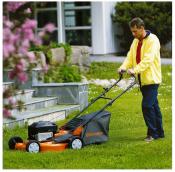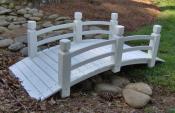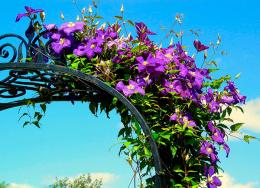Search
Login
Recommended
We make supports for clematis
Particularly beautiful are the plots, in the design of which, they use vertical landscaping. Clematis in the design of vertical landscaping is always the center of attention.
Content
- General information video
- Large-flowered clematis
- Small-flowered Clematis
- Best Places for Clematis
- Clematis support requirements
- Biological features of clematis
- Placement of clematis with different colors
- Making Hanging Carpets
- Clematis in evergreens and tall trees
- Hedge decoration
General information
Vertical gardening in gardening not only decorates the site, but also performs a sanitary-hygienic role. A good landscaping of a personal plot always assumes the presence of vertical gardening.
With the help of such landscaping, you can decorate unsightly buildings, put green screens, decorate arbors, sheds, etc.
Flower lovers receive the highest satisfaction by cultivating these graceful, beautifully flowering vines in gardens and garden plots.
The main varieties of clematis have a variety of flower colors, and flowering is very plentiful and very long.
Many varieties of clematis bloom for two, three or more months.
Large-flowered clematis
Of course, the most beautiful of clematis are large-flowered.
Such luxurious flowering is best used to decorate small sections of walls, verandas.
Registration area should be up to 4-5 square meters, height up to three meters.
Thus, it is possible to create beautifully flowering paintings in a frame on the wall of a house.
When designing the territory, large-flowered clematis is best planted in ceremonial places near the wall or the central flowerbed of the garden or the front garden.
Small-flowered Clematis
It is necessary to note the beauty of small-flowered clematis.
These beautifully flowering vines are well used in vertical landscaping for decorating, shading facades of buildings, staircases, arbors, balconies, grottoes and unsightly farm and household buildings.
If you want to create a hedge, which will be a windproof strip - turn your attention to small-flowered clematis.
Having built long supports, for this you can use a metal profile or corner 20x20, carefully strengthening them with the installation of supports in spans of 2-3 meters, plant small-flowered clematis in a row with a distance of 50 cm.
After the clematis grows, constantly garter the antennae, direct the growth in the right direction.
Do not forget to shade the roots of clematis, feed it, dust it with wood ash.
Clematis is a plant loving the sun, but its legs should always be in the shade.
Best Places for Clematis
The best places for clematis are: south, southwest, southeast place.
If you plant clematis near a column, near trees or pillars, in order to shadow the roots, place clematis on the north side.
On the north side, near the wall or fence, it is recommended to grow the following varieties of clematis: alpine, grape-leaved, Chinese, coarse, mountain, Dawn, Blue Flame, Cosmic Melody.
Such species and varieties grow and bloom well in the shade and in partial shade.
Clematis support requirements
Properly selected supports are an important element in the cultivation of clematis, since with their help, the biological characteristics and decorative quality of clematis are more fully manifested.
Supports should be not only strong, convenient for attaching shoots, but also aesthetic.
Do not forget that after the summer comes autumn and winter, flowers and leaves will disappear and you may see an unsightly picture of ugly supports.
Supports must be installed so that in autumn and winter they can be used as small architectural forms.
As supports, it is good to use wooden and metal lattices, nets of different configurations, poles, arches and stairs.
Pictures from clematis, which are mounted on wooden grates, look very beautiful.
Lattices are made of wooden planks up to 5 cm thick. They are inclined, they can all be decorated with a beautiful frame and attached to the wall of the house.
Biological features of clematis
When choosing supports, it is necessary to take into account the biological characteristics of various varieties.
Varieties Cosmic Melody and Jubilee 70 are very good to use for creating carpet-type compositions, as the flowers are located throughout the liana evenly from top to bottom.
Varieties Climber, Biryuzinka, Serenade of Crimea have flowers at the ends of shoots.
These types of clematis are good to use as garlands, or falling cascades.
Varieties that almost do not cling and are suitable for supports in the form of cylinders are such as: Alyonushka, Anastasia Anisimova, White Dance, Memory of the Heart, Sizaya Bird.
Placement of clematis with different colors
Try to select and combine varieties and forms with flowers and leaves of various sizes and colors to create a beautiful composition.
It is very important to correctly place clematis with different colors of flowers.
To inspect flowers at close range, lianas with violet and blue flowers are planted, since from a distance they are less noticeable.
From a long distance, clematis with light flowers look beautiful: white, pink, yellow. Against a dark background of the wall, or dense greenery of trees.
Clematis with dark-colored flowers look great on a light or gray background.
Making Hanging Carpets
From large-flowered clematis, using various individual supports, you can create hanging carpets, cascades, colored pillows, colorful arches, stretching lianas between trees, you can create garlands.
Keep in mind that on large supports you can place several varieties of clematis, and on small ones only one.
Clematis in evergreens and tall trees
Large-flowered clematis, usually reach 2-3 meters in height, so they are well placed in evergreen trees and shrubs.
Small-flowered species of clematis have a strong growth, they are powerful lianas, so they are well planted in tall trees.
Clematis shoots are very beautifully located between the branches of various trees and shrubs, thereby creating bright hanging flower beds, reaching the ground, they can create a beautiful carpet.
Hedge decoration
To decorate the hedges, the following types of clematis are used: grape-leaved, oriental, paniculate, burning.
In the summer it is a beautiful canvas with graceful flowers, and in the fall - with seeds that are collected in silvery silky fruit.





